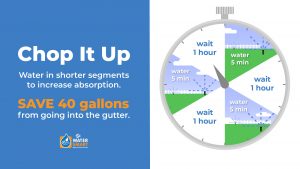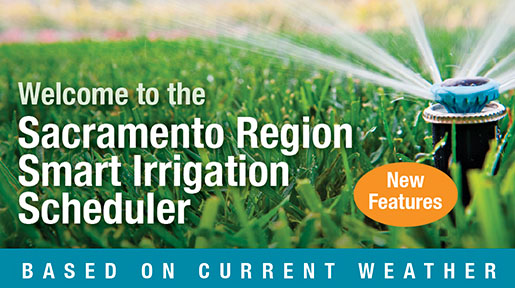By Debbie Arrington
Guest Writer
When it comes to growing healthy plants, water makes all the difference. But do you know how much irrigation your plants really need? And are they getting water when and where they need it?
“Too much sometimes is worse than not enough,” says Justin Black, water conservation specialist for City of Roseville Water.
Folks see yellow spots on their lawn, they increase the run time on their sprinklers, Black notes. Instead of greening that grass, the extra water tends to just run off—especially if that lawn is growing in clay soil.
Soil needs time for water to soak in. Otherwise, excess irrigation flows over the surface—and down the gutter.
Notoriously slow draining, clay soils quickly become saturated—all the pores and air spaces between those tiny clay particles become filled with water. When saturated, soil can’t accept any more water.
 “Clay-based soil with a slight slope becomes saturated in three to five minutes,” Black says. “So, the key is to keep your sprinkler run time under four minutes.”
“Clay-based soil with a slight slope becomes saturated in three to five minutes,” Black says. “So, the key is to keep your sprinkler run time under four minutes.”
One four-minute application may not be enough—particularly in the summer. That’s when local landscapes have their highest water demands. The solution: Cycle and soak.
Explains Black, “Cycle and soak is a way of dividing up sprinkler run times so you maximize the amount of water going into the ground and avoid runoff. Most people run their sprinklers for 10 minutes. Instead run them three times for three minutes, one hour apart.* That allows the pores near the surface to fill and (the water) to seep down to the root zone. You use less water, but it’s more effective.”
Be patient; clay soil takes its time.
“Largely what we have here (in Roseville and much of the Sacramento area) is clay soil and clay can be pretty extreme,” Black notes. In full (or all) clay soil, water soaks in at the rate of 0.03 inches per hour. Traditional sprinkler systems deliver 1.5 inches of water per hour—50 times the full clay soak rate.
While clay is heavy, most of our soils aren’t “full clay;” an hour between sprinkler applications is usually enough time for water to soak down to a lawn’s root zone.
“Cool-season turfgrasses—and that’s what most people grow—need about 64 minutes a week on spray sprinklers in July; that’s the maximum,” Black says. “For 100 percent (of that maximum), run the sprinklers four days, four times (a day) for four minutes.”
Another way to break down that 64 inches: Two days, eight times a day—split between early morning and early evening—for four minutes.
“When setting up a smart controller, program for the hottest weather—that maximum water use—then work down from there,” Black explains. “Then, seasonally adjust amounts on your controller down from that high point.”
That’s where a smart sprinkler timer comes in really handy. Once programmed, it takes care of those adjustments.
“Your sensors will do it automatically,” Black notes.
Smart timers also allow more flexibility with setting multiple short run times.
Setting up the smart timer, which uses an app for easy access, can be daunting. The most common mistake is inputting the wrong basic information for the specific landscape.
For local lawns, the most common settings include cool-season turfgrass, full sun, clay soil and 10 to 15 percent slope.
“Programming for warm-season grass when you have cool-season, your lawn won’t get enough water,” Black says.
Help get the most out of the cycle-and-soak method with rotary sprinkler nozzles. Bigger drops come out of the rotating heads at a slower rate than traditional spray sprinklers, cutting down on evaporation and waste.
When upgrading sprinkler heads, make sure to change out all the heads on an irrigation station, Black advises. “Keeping the same is important instead of mismatching. When you mismatch, you damage distribution uniformity (DU)—how the water is distributed. With a system with 50 percent DU, to keep areas alive (with lower DU), you have to double-water other areas. Anything you can do to promote DU really makes a difference.”
So does proper watering overall.
“With the cycle and soak method, you can save water and still have greener, healthier grass,” Black says. “Because you’re minimizing runoff, you get more water to the root zone and better looking plants as a result.”
Find rebates for smart sprinkler timers and irrigation upgrades at BeWaterSmart.info/rebates.
Debbie Arrington is a longtime home and garden reporter and co-author of the blog Sacramento Digs Gardening: https://sacdigsgardening.californialocal.com/
Exact cycle times to avoid runoff vary by individual yard and are influenced by sprinkler type, soil type, plant type and landscape slope. As a general rule, keep cycles to 5 minutes or less.
*

